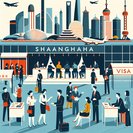
China has switched on a brand-new immigration channel — the K-Visa — aimed squarely at drawing the world’s top scientists and engineers to its research parks and high-tech manufacturers. Announced in late October and formally rolled out this week, the permit is being marketed as Beijing’s answer to the U.S. H-1B program, but with two attention-grabbing differences: applicants do not need a pre-arranged job offer and the quota is uncapped.
Under the rules published by the National Immigration Administration, foreign nationals with at least five years of experience in designated frontier fields (AI, semiconductors, quantum, robotics, biomedicine, green tech) may apply online and receive a five-year, multiple-entry visa within 20 working days. Spouses and minor children are granted derivative K-Visas automatically. Holders may change employers inside China without re-approval, and may convert to permanent residence after three consecutive years of tax filings above a prescribed salary floor.
![China Officially Launches Innovative “K-Visa” to Lure Global Tech Talent]()
Officials have been unusually frank about the geopolitical backdrop. At a Ministry of Science and Technology briefing, vice-minister Zhang Yuzhou said “heightened external restrictions on Chinese firms” make it imperative to “import brains” even as the U.S. raises H-1B fees and scrutiny. Consultancy Fragomen told clients that inquiries from India, Southeast Asia and parts of Europe “spiked within hours” of the final regulations going live.
For multinationals already operating R&D centres in Shanghai, Shenzhen and Beijing, the K-Visa removes their biggest pain-point: long lead times to bring in short-notice specialists for system roll-outs and factory troubleshooting. Global chip-equipment maker ASML estimates it will cut deployment times for Dutch engineers by four weeks per assignment. Tech recruiters caution, however, that language, schooling and data-security rules remain significant obstacles to long-term retention. Domestic graduates worry the influx could tighten an already brutal job market, but policy advisers counter that China still has a shortfall of 300,000 senior-level semiconductor engineers alone.
Practically, mobility managers should update assignment cost models: K-Visa holders are exempt from the standard foreigner work-permit points test, but companies must still apply for a separate work notification letter within 15 days of arrival. HR teams are also advised to build cultural-integration programs to offset concerns over censorship, social media restrictions and family spousal employment rights, which the new visa does not yet address.
Under the rules published by the National Immigration Administration, foreign nationals with at least five years of experience in designated frontier fields (AI, semiconductors, quantum, robotics, biomedicine, green tech) may apply online and receive a five-year, multiple-entry visa within 20 working days. Spouses and minor children are granted derivative K-Visas automatically. Holders may change employers inside China without re-approval, and may convert to permanent residence after three consecutive years of tax filings above a prescribed salary floor.

Officials have been unusually frank about the geopolitical backdrop. At a Ministry of Science and Technology briefing, vice-minister Zhang Yuzhou said “heightened external restrictions on Chinese firms” make it imperative to “import brains” even as the U.S. raises H-1B fees and scrutiny. Consultancy Fragomen told clients that inquiries from India, Southeast Asia and parts of Europe “spiked within hours” of the final regulations going live.
For multinationals already operating R&D centres in Shanghai, Shenzhen and Beijing, the K-Visa removes their biggest pain-point: long lead times to bring in short-notice specialists for system roll-outs and factory troubleshooting. Global chip-equipment maker ASML estimates it will cut deployment times for Dutch engineers by four weeks per assignment. Tech recruiters caution, however, that language, schooling and data-security rules remain significant obstacles to long-term retention. Domestic graduates worry the influx could tighten an already brutal job market, but policy advisers counter that China still has a shortfall of 300,000 senior-level semiconductor engineers alone.
Practically, mobility managers should update assignment cost models: K-Visa holders are exempt from the standard foreigner work-permit points test, but companies must still apply for a separate work notification letter within 15 days of arrival. HR teams are also advised to build cultural-integration programs to offset concerns over censorship, social media restrictions and family spousal employment rights, which the new visa does not yet address.









